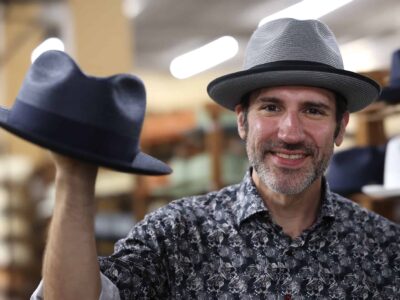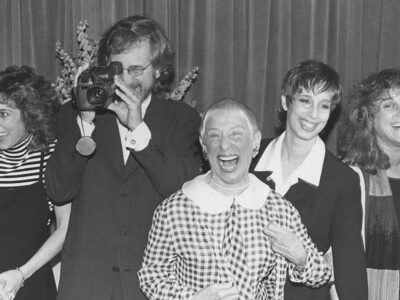By Deborah Fineblum/JNS.org
When she was in her 30s, Janet Buchwald fell head over heels in love.
With the Hebrew language.
Three decades later, whenever the 65-year-old Sudbury, Mass., resident itches to expand her Hebrew vocabulary with a tantalizing new verb, or to find an answer to a particularly thorny question for a student, she looks no further than her favorite websites.
At 69, Michael Vigdorchik feels like he’s playing a game of catch-up, something his online resources make possible. “When you grow up in the former Soviet Union, religion comes harder,” says the Ukraine native who now lives in St. Louis. “You have to take it slowly and ask a lot of questions. This I can do at Chabad.org.”
Whenever Charlotte Gottlieb prepares a holiday workshop for the Jewish culture group she runs at her independent living center in Chevy Chase, Md., she typically looks no further than Aish.com. “They always have great stories and holiday traditions that I never heard of,” says Gottlieb, who with three other women ages 85-90 is hard at work preparing for her bat mitzvah (eight decades later) this spring. At 93, she is the senior member of the group.
Dr. Elliott Milgram may live in the Israeli coastal town of Nahariya, but thanks to his trusty computer, Milgram’s Torah and Talmud learning comes from all over the Jewish world. Tapping into such sources as Bar-Ilan University, Chabad, Aish, and Yeshivat Har Etzion, Milgram enjoys learning that resonates with his modern Orthodox and Zionist worldview. “These commentaries are part of our Jewish heritage,” says the 80-year-old retired pediatrician. “The online classes and writings help us to understand who we are and why we are here.”
The over-55 demographic, though not born with a keyboard in their hands like their grandchildren, is quickly warming to expanding their Jewish horizons online. In fact, this age bracket represents the fastest-growing group of Internet users these days, including what used to be an exclusive domain of the young: Facebook.
Chabad.org was early out of the gate. Back in the 1980s, when the Internet had yet to take hold of the world, Chabad was pioneering the online outreach field. What Chabad.org spokesman Chaim Landa notes was “one of the first pages on the Internet” today serves as what he calls “Judaism’s homepage,” garnering 44 million annual unique visitors.
Among those millions, Landa says that based on the feedback Chabad.org receives, an increasingly large chunk falls in the over-60 demographic. One offering that’s popular with seniors is Torah Trainer, which teaches even beginners to chant from the Torah.
“Chabad.org has answered a lot of questions I send in: Why do we eat kosher food? What does Judaism say about conversion?” says Michael Vigdorchik. “The answers are sometimes a little bit surprising—and always interesting. My wife and I like to discuss them.”
An ever-expanding playing field of Jewish websites continues to push the envelope for Jewish learning with multi-media and creative new services—like Aish.com’s 24-hour live webcam broadcasting from the Western Wall in Jerusalem. Much of this creativity tends to appeal to older users who suddenly find themselves with more discretionary time on their hands.
“The younger people want whatever they can get in 10 minutes, but the seniors tend to watch our longer classes, because they have the time and the patience,” says Shoshie Nissenbaum, women’s program director for Naaleh.com, home to thousands of lectures and ongoing courses from popular Torah teachers like Rebbitzin Tziporah Heller. Most of Naaleh.com’s 30,000 members are 55 and older, she says.
“The 30-50 audience is pulled in too many directions, but the mature ones love it all, from those who never had a chance to learn and take the beginner’s classes to the advanced learner,” says Heller.
Websites like that of the Aleph Beta Academy (www.alephbeta.org) attract users with eye-catching multimedia content. Using animated videos, CEO Rabbi David Fohrman employs 15 artists, Internet pros, and others to create animated insights into the Torah and other Jewish texts. Aleph Beta now boasts 4,500 subscribers and 25,000 others who receive the website’s weekly email.
Aleph Beta followers tend to be the over-50 crowd and youngsters who love animation.
“The older followers aren’t digitally native like the kids, so we work at making the site easy to use,” says Fohrman. “Older users are willing to go for a deep dive. They have the attention span and sophistication for longer series and appreciate the bittersweet parts of life, like enjoying red wine and dark chocolate later in life.” One appeal for seniors is that they can show the Aleph Beta “cartoons” to their grandchildren.
Janet Buchwald testifies that online resources have been a boon to her Jewish learning, especially when it comes to the Hebrew language.
“In my 30s, I was seized by a passion to learn Jewishly and discovered there was a voice in there,” she says. In the years that have followed, Buchwald has led High Holiday services, including at the Massachusetts Institute of Technology. She also pinch-hits for the rabbi and cantor at her synagogue in Sudbury when they are away, and tutors bar/bat mitzvah students who have a habit of asking tough questions.
“The Web has everything but you have to really know your source,” she says, “and be very, very careful with what you pass on.” Her favorite websites include Aish.com, Chabad.org, and the Jewish Virtual Library. But when she’s not on the job, Buchwald will often direct her browser to another dose of Hebrew. Last week’s new word: tampon (Note: the Hebrew is…tampon, a cognate).
Other Jews turn to their computer, tablet, or even their smartphone to participate in Shabbat and holiday services. When Lynn Wagner lived in Cincinnati, Ohio, she attended Congregation Beth Adam. She has moved to Portland, Ore., but continues to “attend” Beth Adam for Friday night and holiday services as well as on the yahrzeit (anniversary of death) of her parents—all online.
“What’s so nice is I can stream it anytime if I am not available at that hour,” says Wagner, 70. “With these services, I feel like I’m still there. And I try not to miss the rabbi’s podcasts. My iPad goes with me everywhere, even to bed.”
Robert Barr, the Beth Adam rabbi who records those podcasts, is quick to point out the power of online Judaism, especially for older Jews.
“Nine years ago, we recognized the changes we were seeing,” he says. “We now have an online congregational rabbi, tens of thousands watching our High Holiday services, and 36,000 on our Facebook page. We’re reaching and interacting with people from all over.”
Chief among them are older Jews unable to get out for services and others who live in isolated areas, says the rabbi.
“What’s striking is people experience being part of a community,” Barr says. “They feel strongly connected to something Jewish.” I
In fact, Barr recently conducted an online baby naming for a far-flung family, with the proud grandparents tuning in from Florida.
“Technology is getting easier and easier every year,” he says. “[Seniors’] grandchildren set them up and tell them, ‘Grandma, just push this button. Don’t worry. You can’t break it.'”
“All these years we lived without a computer and now it seems like we can’t live without one,” says Charlotte Gottlieb, the 93-year-old Aish.com fan. “For many of our [independent living] center’s residents who knew they were Jewish but grew up without real Yiddishkeit, this is their chance. Now they can finally have it too.”











Comments